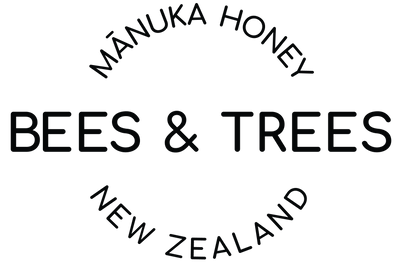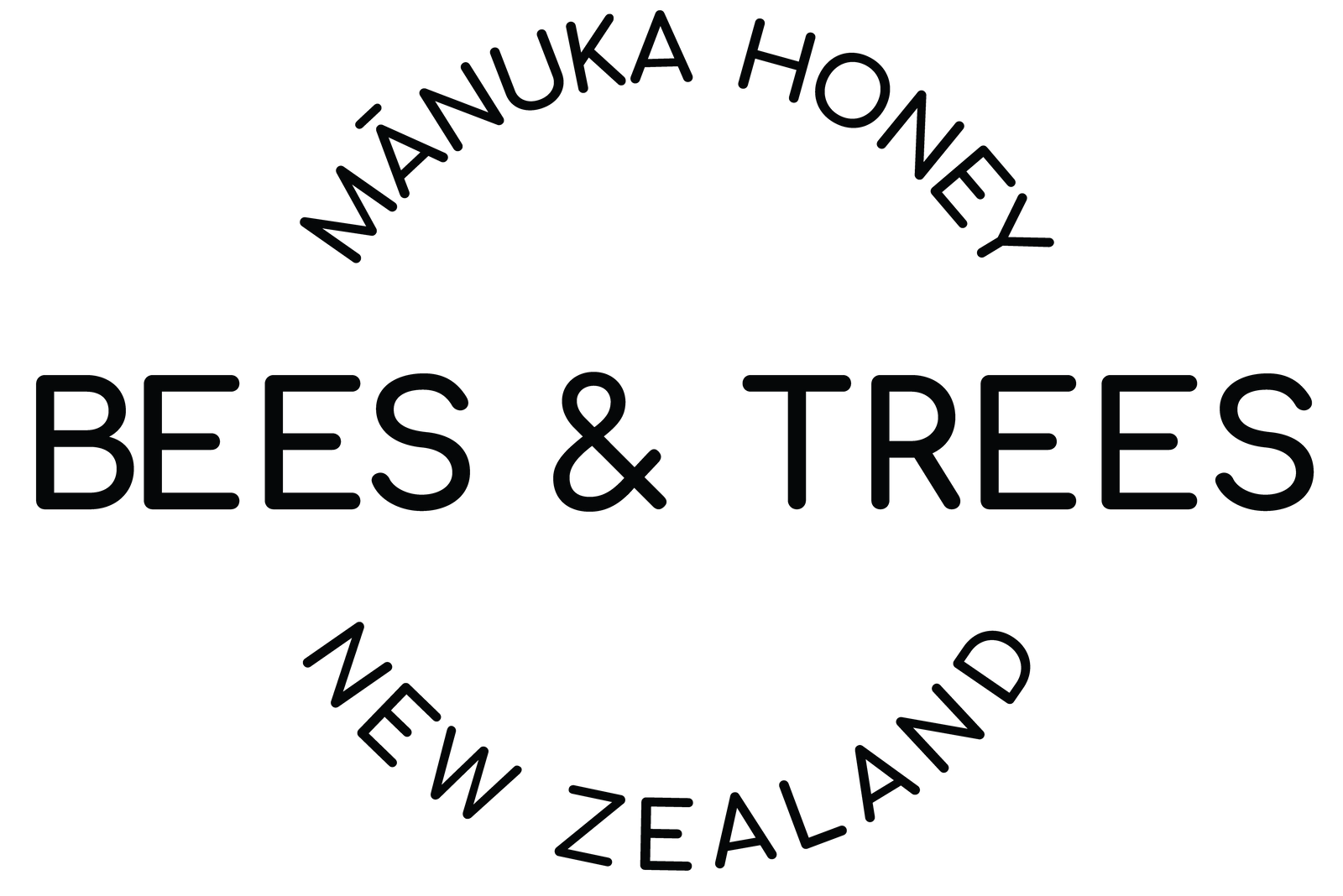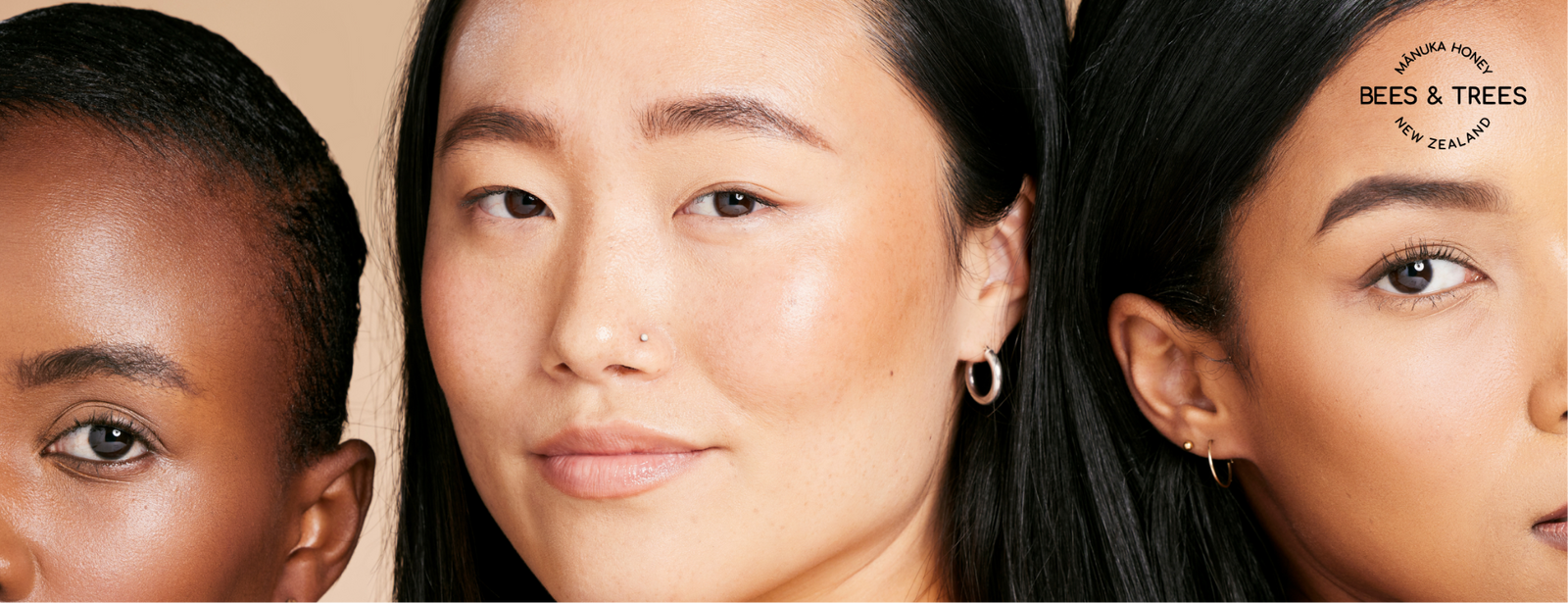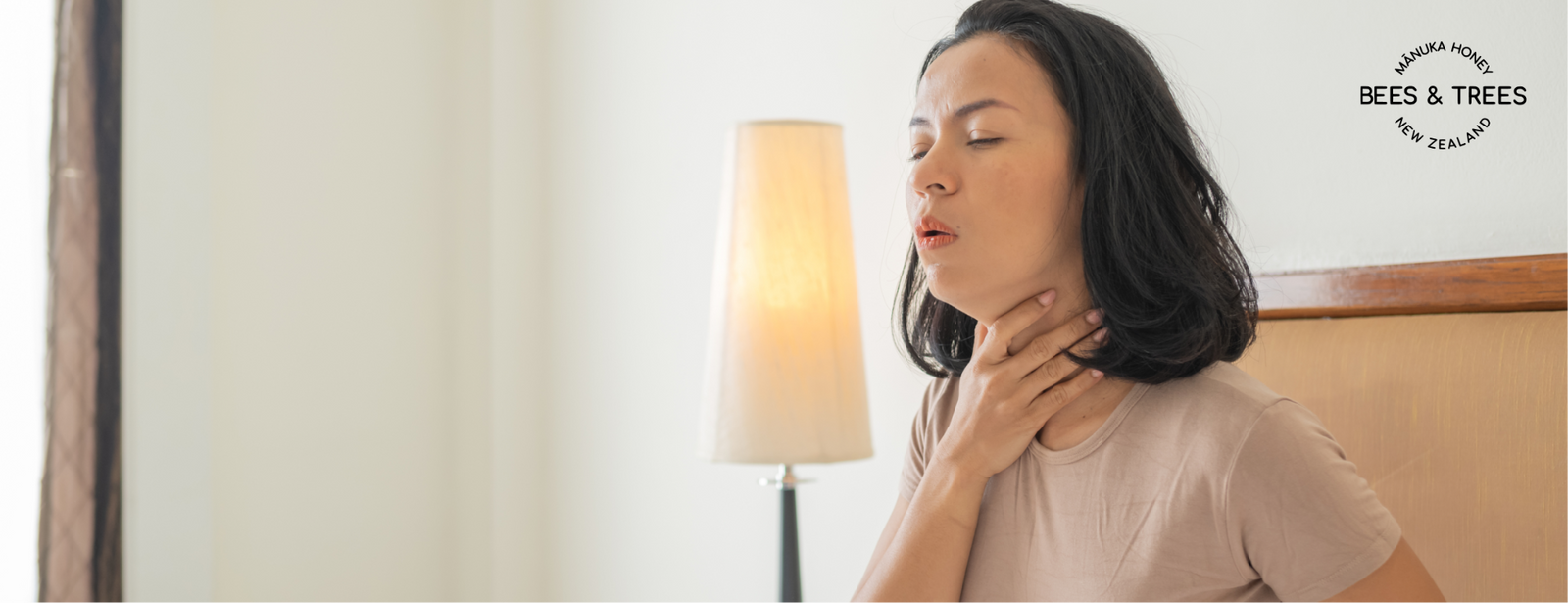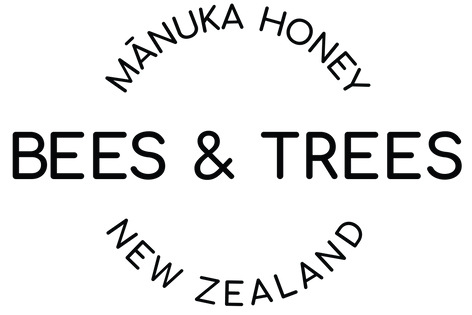There are numerous brands of Manuka honey available in the market today. At a single store you can encounter the terms “Monofloral Manuka”, “Manuka”, “Multi-floral Manuka” or “Manuka honey blend”. This can be incredibly confusing.
In this article, we will explain these terms, along with detailing the process by which Manuka honey authenticity is determined and what to look for when buying Manuka honey.
But before we get into what Manuka honey blend means, we need to start from the beginning: What is Manuka honey, and what makes it special?
What is Manuka Honey?

Manuka honey is honey that is produced by bees after foraging on the flowers of the Manuka tree (Leptospermum scoparium), which is native to and grows predominantly in New Zealand. Mānuka is the original Māori name of the tree, but the spelling without the macron has become popular and accepted globally. The Manuka tree has white flowers and a strong earthy scent and flavor.
Manuka honey contains one main compound that sets it apart from other types of honey produced around the world, called Methylglyoxal. According to research, Methylglyoxal concentration is directly related to the antibacterial properties of Manuka honey.
Manuka honey is more viscous than other honeys and normally has a dark cream or dark brown color. It's also rich in other nutrients such as amino acids, vitamins, flavonoids, enzymes, phenolic acids, minerals, and proteins which contribute to the many benefits of Manuka honey, like wound healing, antitumoral, antioxidant, and anti-inflammatory effects. To explore the specific therapeutic benefits of Manuka honey for inflammatory conditions like ulcerative colitis, read our detailed examination [1]
What Makes Manuka Honey Special?

You might be wondering, “Why is Manuka honey so special?” In addition to the extensively researched health & wellness properties, there are three things that differentiate it from other types of honey scientifically. They are:
-
Non-Peroxide Activity
Dr. Peter Molan, a biochemist from the Waikato University in New Zealand, was studying the properties of honey which arise from “hydrogen peroxide” produced as a result of glucose oxidase in honey interacting with water when he made a very interesting observation. He noticed that Manuka honey was special and unique in that it exhibited a different property which he called “non-peroxide activity” (NPA). In the early days, NPA was measured by observing the inhibition of the growth of bacteria within honey samples.
In this particular study, New Zealand honeys were investigated for antibacterial activity with and without the presence of hydrogen peroxide. For the Manuka honey sample, Staphylococcus aureus bacteria was inhibited after neutralizing the hydrogen peroxide effect. This study and subsequent research by Dr. Molan launched the worldwide interest in Manuka honey as a wellness and healing product. [2]
-
Methylglyoxal Content
In 2008, Professor Thomas Henle of the Technical University of Dresden set out to investigate what was producing the antibacterial effect in Manuka honey. He identified methylglyoxal (MGO) as the compound that directly correlated to the non-peroxide activity of Manuka honey. It was this discovery that enabled the development of a measure for the concentration of MGO related to the honey’s purity and potency. This paved the way for more consistent and accurate results, quickly making it the primary testing standard for producers and packers.
Methylglyoxal is formed through a natural process as the honey ages. It is produced through the conversion of dihydroxyacetone (DHA) in maturation. [3] The levels of methylglyoxal can be directly measured, rendering testing faster and more repeatable. The higher the MGO rating, the more potent the honey benefits.
-
Leptosperin Content
Leptosperin is a special and unique compound found in Manuka flower nectar only. It's used as an authenticity marker and is also known to contain anti-inflammatory properties.
Monofloral Manuka Honey Vs. Multi-floral Manuka Honey

Growing markets coupled with the high relative price of Manuka honey spawned a lot of shady practices with honey adulteration and misleading labeling practices in the industry. In response, the New Zealand government came up with a regulatory framework that is used to control Manuka honey labeling. They established two honey levels based on key indicators: monofloral Manuka honey and multi-floral Manuka honey.
The framework uses five markers to authenticate and differentiate monofloral Manuka honey, multi-floral Manuka honey, and non-Manuka honey. It uses four chemical characteristics and one DNA marker, which are unique to Manuka flowers. These tests are referred to as the MPI 5 markers within the industry. [4] [5]
Through these standards and testing requirements, the New Zealand government regulates labeling for all honey packed and exported from New Zealand. The terms “Manuka Honey,” “Monofloral Manuka Honey,” “Multi-floral Manuka Honey,” or “Manuka Honey Blend” now have defined regulatory meanings established to help protect consumers.
Monofloral Manuka Honey (Manuka Honey)

Monofloral Manuka honey has a higher concentration of the various markers, which then indicates that the bees were foraging more on the Manuka flowers than other floral types.
Alternatively, it means that the packer did not dilute the Manuka honey with much, if any, other honey. For Manuka honey to be classified as monofloral, it must pass the MPI 5 markers discussed below:

If it doesn’t reach these threshold levels for the MPI markers, it is then classified as multi-floral Manuka honey. Monofloral Manuka honey has different levels of potency with regards to its wellness properties depending on the amount of MGO content present in it.
Multifloral Manuka Honey (Manuka Honey Blend)

Manuka honey blend (Multifloral Manuka honey) is produced when bees forage on various nectar sources, including Manuka flowers. It can also be created when Manuka honey is mixed with other honey types after extraction.
When beehives are placed where there’s a lot of Manuka flowering, beekeepers are able to get pure monofloral Manuka honey. However, in New Zealand, some areas have other plants that flower at the same time as the Manuka. When that happens, the bees may blend nectar from Manuka with other flowers, thus creating a Manuka honey blend, which may be less potent than pure monofloral Manuka honey. The government carefully regulates what can be called Manuka honey and Manuka honey blend using the scientific grading system discussed below.
Multifloral Manuka honey normally has lower MGO levels than monofloral Manuka honey and may possess some health benefits. For honey to be classified as multi-floral Manuka honey, there are thresholds it must pass with regard to the MPI 5 markers, including:

If honey fails to meet any of these requirements, it is classified as non-Manuka honey.
Methylglyoxal Test Results & Correlated Rating Scales

-
-
Methylglyoxal Testing (MGO)
As stated earlier, MGO concentration correlates to the antibacterial and other wellness properties of Manuka honey. MGO concentrations generally range from 100-1000 or higher. MGO concentrations above 800 comprise less than 10% of the honey produced each year in New Zealand, and these honeys are correspondingly more expensive. The vast majority of research conducted on Manuka honey has used honey with an MGO content of 250 mg/kg or above.
Many Manuka honey brands (including Bees & Trees Manuka Honey) find that putting the actual test results of MGO concentration on the label is the clearest and most transparent way to communicate the purity and concentration of Manuka honey in the jar. These brands might have a MGO250+, MGO400+ , MGO550+, etc. The number that follows ‘MGO’ refers to the methylglyoxal concentration in mg/kg. The higher this concentration, the better the honey's antibacterial and other wellness effects.
-
UMF Rating Scale
There is another legitimate way of rating the activity level of Manuka honey, and that is with a UMF rating system. UMF means “Unique Manuka Factor,” a term trademarked by the Unique Manuka Factor Honey Association in New Zealand. It is used to indicate the authenticity, potency, and purity of Manuka honey and directly correlates to the MGO content available in the honey. The UMF scale ranges from 0-20. UMF-rated honey is also tested for HMF (Hydroxymethylfurfural- an organic compound formed from the breakdown of fructose) and Leptosperin.
Brands utilizing the UMF rating system might show a 5+, 10+, or 15+ UMF rating to designate the purity of the honey and the corresponding antibacterial and other wellness properties. Some non-UMF brands try to hijack this system by using words like “Active,” “Bioactive,” or “Factor,” followed by a number like 10+ or 15+. Don’t be fooled by this approach, as, in most cases, these values don’t align with the UMF rating system, and these honeys typically fall at the very low end of the MGO content scale (i.e., 100MGO or less). -
Summary

If all of this seems complicated and confusing, it is not just you. There is a lot of information here. We’ll try to sum it up and pull the various pieces together. The main goal is to be able to read a label, recognize a fair value and appropriately choose the best honey based on what you want to achieve.
Multifloral Manuka honey normally has an MGO content of 50-100 mg/kg, which is at the very low end of the scale. The majority of science and medical research around Manuka honey starts with MGO250+ or higher honey. While honey with lower MGO content may still possess some health and wellness benefits, there is no evidence-based support for that idea. Further, the pricing of this honey should be low enough to reflect the lack of MGO content (i.e., low level of actual Manuka honey in the jar).
Monofloral Manuka honey without an MGO result on the label or UMF rating likely has an MGO content around 100 mg/kg, or in some cases, slightly lower. So beware of brands boasting that they meet the standard for Monofloral Manuka honey without prominently displaying their MGO test results or a UMF rating.
To ensure you get authentic monofloral Manuka honey, look out for the MGO or UMF rating on the jar you intend to buy. We recommend honey with at least 250 mg/kg of Methylglyoxal or a 10+ UMF rating in order to see a wellness effect from the honey. Also, check to see if the honey you want to buy has been tested and if you can access the actual test results online.
Bees & Trees - Real Manuka Honey

One of the core values and hallmarks of our brand is transparency and education. We independently test all of our honey and make the test results available on our website. We are passionate about the health of our bees, the careful production of our crop, and the resulting quality of the honey we pack for our customers.
There are a number of good quality Manuka honey brands available on the market, but there are also a number of brands utilizing opaque labeling and rating systems that create noise, confusion, and don’t deliver value for the price they command.
Find a brand you trust, get to know the company, and stick with them. We hope you try Bees & Trees Manuka Honey; check our website and see what our customers are saying in their reviews.
Appendix:
-
https://www.sciencedirect.com/science/article/abs/pii/S2212429221001632
-
https://www.tandfonline.com/doi/abs/10.1080/00218839.1988.11100783
-
https://magritek.com/2021/01/29/identification-and-quantification-of-methylglyoxal-in-manuka-honey/
-
https://www.mpi.govt.nz/food-business/honey-bee-products-processing-requirements/manuka-honey-testing/#:~:text=The%20test%20for,3%20fg/%C2%B5L.
-
https://www.analytica.co.nz/media/0fmfax5m/honey-test-results-from-this-season_-analytica_-june-21.pdf
